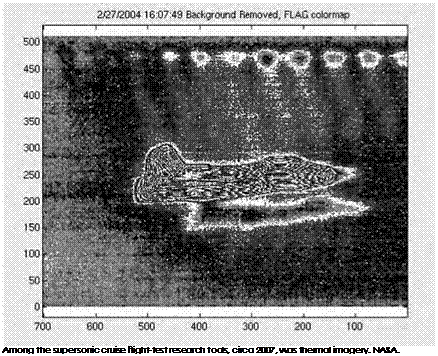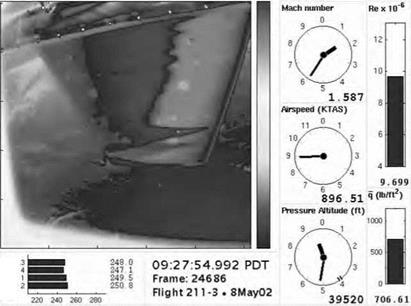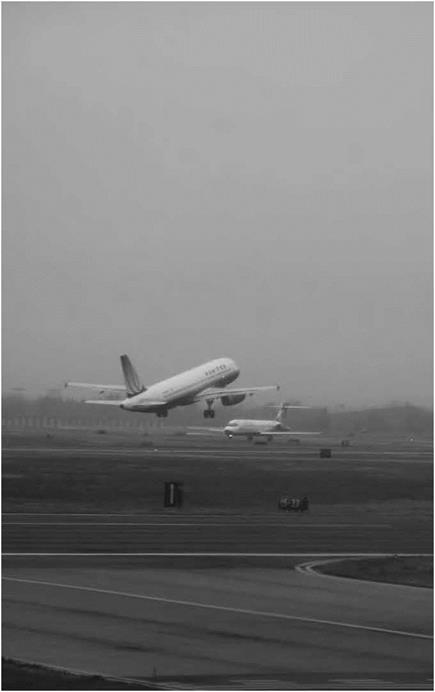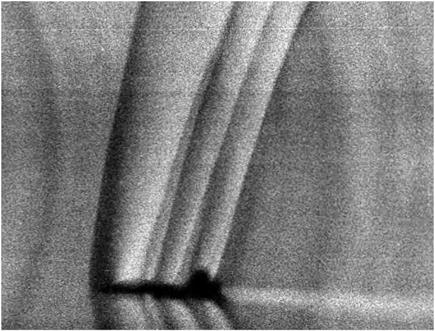Into the 21st Century
![]() In 2004, NASA Headquarters Aeronautics Research Mission Directorate (ARMD) formed the Vehicle Systems Program (VSP) to preserve core supersonic research capabilities within the Agency.[1118] As the program had limited funding, much of the effort concentrated on cooperation with other organizations, notably the Defense Advanced Research Projects Agency (DARPA) and the military. Likely configuration studies pointed toward business jets as being a more likely candidate for supersonic travelers than full-size airliners. More effort was devoted to cooperation with DARPA on the sonic boom problem. An earlier joint program resulted in the shaped sonic boom demonstration of 2003, when a Northrop F-5 fighter with a forward fuselage modified to reduce the type’s characteristic sonic boom signature demonstrated that the modification worked.[1119]
In 2004, NASA Headquarters Aeronautics Research Mission Directorate (ARMD) formed the Vehicle Systems Program (VSP) to preserve core supersonic research capabilities within the Agency.[1118] As the program had limited funding, much of the effort concentrated on cooperation with other organizations, notably the Defense Advanced Research Projects Agency (DARPA) and the military. Likely configuration studies pointed toward business jets as being a more likely candidate for supersonic travelers than full-size airliners. More effort was devoted to cooperation with DARPA on the sonic boom problem. An earlier joint program resulted in the shaped sonic boom demonstration of 2003, when a Northrop F-5 fighter with a forward fuselage modified to reduce the type’s characteristic sonic boom signature demonstrated that the modification worked.[1119]
 |
Military aircraft have traversed the sonic regime so frequently that one can hardly dignify it with the name "frontier” that it once had.
10
![]()
|
|
|
|

In-flight thermography output. NASA.
![]() Nevertheless, there have been few supercruising aircraft: the SR-71, the Concorde, the Tu-144, and the F-22A constituting notable exceptions. The operational experience gained with the SR-71 fleet with its DAFICS in the 1980s, and the more recent Air Force experience with the low – observable supercruising Lockheed-Martin F-22A Raptor, indicate that a properly designed aircraft with modern digital systems makes high Mach supersonic cruise now within reach technologically. Indeed, at a November 2007 Langley Research Center presentation at the annual meeting of the Aeronautics Research Mission Directorate reflected that although no supersonic cruise aircraft is lying, digital simulation capabilities, advanced test instrumentation, and research tools developed in support of previous programs are nontrivial legacies of the supersonic cruise study programs, positioning NASA well for any nationally identified supersonic cruise aircraft requirement. Whether that will occur in the near future remains to be seen, just as it has since the creation of NASA a half century ago, but one thing is clear: the more than three decades of imaginative NASA supersonic cruise research after cancellation of the SST have produced a technical competency permitting, if needed, design for routine operation of a high Mach supersonic cruiser.[1120]
Nevertheless, there have been few supercruising aircraft: the SR-71, the Concorde, the Tu-144, and the F-22A constituting notable exceptions. The operational experience gained with the SR-71 fleet with its DAFICS in the 1980s, and the more recent Air Force experience with the low – observable supercruising Lockheed-Martin F-22A Raptor, indicate that a properly designed aircraft with modern digital systems makes high Mach supersonic cruise now within reach technologically. Indeed, at a November 2007 Langley Research Center presentation at the annual meeting of the Aeronautics Research Mission Directorate reflected that although no supersonic cruise aircraft is lying, digital simulation capabilities, advanced test instrumentation, and research tools developed in support of previous programs are nontrivial legacies of the supersonic cruise study programs, positioning NASA well for any nationally identified supersonic cruise aircraft requirement. Whether that will occur in the near future remains to be seen, just as it has since the creation of NASA a half century ago, but one thing is clear: the more than three decades of imaginative NASA supersonic cruise research after cancellation of the SST have produced a technical competency permitting, if needed, design for routine operation of a high Mach supersonic cruiser.[1120]

|











